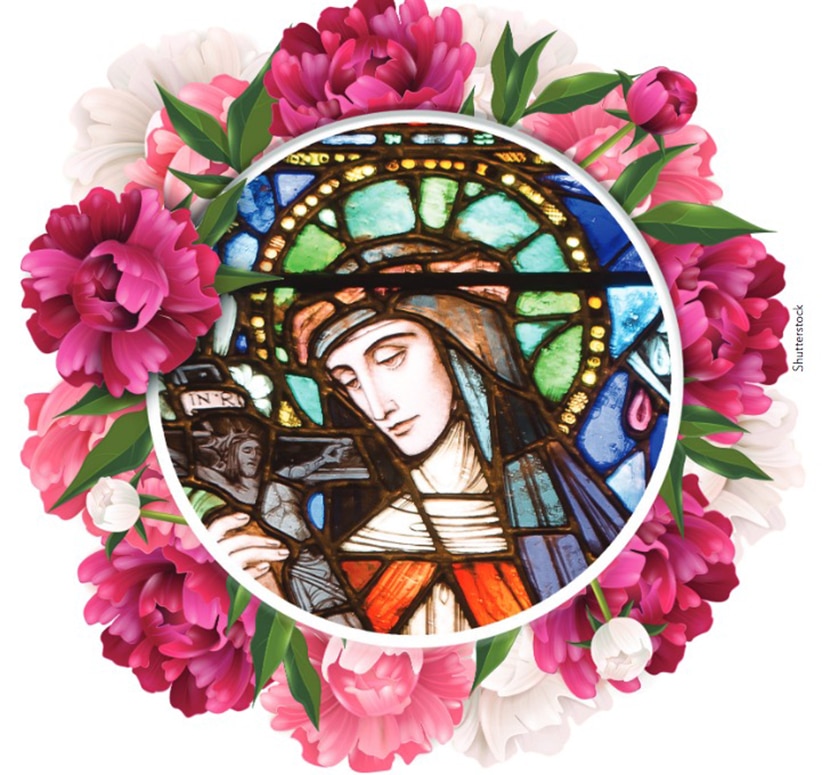In a world grown cold without wonder, how do you reimagine the drama and joy of Christianity? For C.S. Lewis, the answer was to invite us into a different world that would help us see this one with fresh eyes. That world was Narnia, and when Lewis wrote that world into existence, he created more than a story — he created the possibility for a moral and spiritual journey.
“The Chronicles of Narnia” span seven books, each a narrative unto itself, that come together to form a larger whole. Lewis started writing these stories with “The Lion, the Witch, and the Wardrobe” (published in 1950) because he had this image in his mind of a faun standing next to a lamppost, and he wanted to tell a story about that. In the course of writing that first story, it soon became a Christian story because he imagined what kind of redeemer a world like the one he was imagining would need.
By the time he published the last book in the series (“The Last Battle,” 1956), he had managed to create an adventure filled with beloved characters that did not tell children the truths of Christianity but rather gave them images that would show children the beauty. He had only meant to write a story as a gift to his goddaughter, but he ended up creating one of the enduring classics of the 20th century. And since he wrote them for a child, these stories are, of course, appropriate for children. The kicker, though, is that they are inappropriate for anyone hopelessly convinced of their own sophistication. You have to be childlike to enjoy these chronicles, which also means that learning to enjoy them (or to enjoy them again) is an exercise of being restored to childlike wonder.
Narnia is a place where the choices and actions, the desires and dispositions of children affect their own destinies and the fate of the world. It is a place where children learn what it means to grow in maturity, to become responsible and to develop character. They learn what it means to love the one who calls them into being and who gives them a mission in life — a mission that matters on the grandest scale. Above all, what children learn in Narnia is the importance of remaining childlike, and that means that Narnia is a place where adults can always start over in relearning what is all too quickly forgotten.
You can read “The Chronicles of Narnia” at any time, but since the books immerse readers in sorting out true desires from false ones, strengthening the will and exercising courage, and becoming evermore responsive to the voice of the Creator and Redeemer, these stories are especially well-suited for the seasons of Lent and Easter. This doesn’t mean that reading children’s literature should take the place of prayer, fasting and almsgiving, or even that it’s a substitute for reading Scripture. Instead, engaging the Chronicles softens our defenses and opens up space within our hearts and minds for welcoming the joy of Christ, in whom the drama of all life bursts forth. This is especially important in a world grown cold without wonder.
Leonard J. DeLorenzo, Ph.D., serves in the McGrath Institute for Church Life and teaches theology at the University of Notre Dame. His latest book is “What Matters Most: Empowering Young Catholics for Life’s Big Decisions” (Ave Maria Press, $16.95).
How to make a spiritual journey through Narnia
It takes no great insight to point out that relative to the Easter season, Lent gets the lion’s share of attention. There is program after program, book after book, blog post after blog post dedicated to making the most out of Lent, and then Easter comes and all that intentionality and focus scatters to the wind before the first week is through. So here’s a small idea: Why not take on a commitment — a practical and enriching exercise — that spans from the beginning of Lent to the end of Easter? Reading “The Chronicles of Narnia” can be such a commitment.

Beginning the week in which Ash Wednesday falls (March 3-8) to the week that leads to Pentecost (June 2-8), there are 14 weeks total from Lent through Easter. There are seven books in the Narnia series. Reading one book every two weeks would mean reading a chapter or two every day. The practical considerations for taking on this commitment in liturgical time are therefore pretty straightforward: This is a commitment that requires regular but not burdensome attention.
This commitment is more than a practical matter, though; it is also a potentially spiritual one. Reading “The Chronicles of Narnia” as a spiritual exercise does not mean being somber and stern-browed; it doesn’t mean reading without any enjoyment. What it does mean is doing more than just light reading and requires just a little more work. That work is the work of conscious reflection that might, at times, invite an examination of conscience and inform how you pray. The easiest and perhaps best way to move from light reading to spiritual reading is to do two simple things. First, to keep a reading journal and second, to engage with a reflection partner or small group.
The point of a reading journal is to foster regular, habitual reflection on the moral and spiritual themes running through each of the chronicles. Since there are between 15 and 17 chapters in each of the seven books, I would suggest taking about 20 minutes every four chapters or so to journal about the key instances where someone’s character is tested, or a moral decision is made, or a spiritual insight emerges. You can also just copy down any especially telling lines or paragraphs. You might ask yourself, “What is at stake in what’s going on?”, “How are the characters growing or changing?”, and “What fears and hopes are motivating their actions?”
Then at the end of each book, take 30 or 60 minutes to write out your own spiritual reflection on the story. You might think about what sorts of spiritual qualities or character development this particular journey through Narnia has called forth. And you might reflect on those things in your own life.
The point of having a reflection partner or small group is to allow this spiritual journey through Narnia to become a communal endeavor. If a couple or several adults (including teens and young adults) agree to read the books on a common schedule (again, one book every two weeks, beginning the week of March 3 and concluding with Pentecost), then joining together for substantive discussions after each book would be time well-spent. The basis for these conversations can be the reading journals each person keeps. Literary insights, personal resonances and liturgical connections may all follow suit.
What you might find while journeying through Narnia
Though it is always an act of injustice to a story (at least a good story) to say, “This is what it is about … “, it may still be helpful to briefly name some of the broader themes to be attentive to when reading through “The Chronicles of Narnia” as a spiritual journey. And please note, the following order is definitely the order in which you should read the books!
These themes are all intentionally broad since the point of a spiritual journey is not to unlock some secret code. It is not the case that we are meant to decipher these stories to find the real or hidden message, and then move along as if the story was only a carrier for the thing that really mattered. All too often we treat literature, and Scripture, and even other people like that — as if there is something for “me” to “get from it” rather than something or someone to encounter. The motivation to just “get something from it” is not conducive to having our wonder awakened, our desires stirred, our consciences challenged or our gratitude enkindled.
It is also a good reminder that “The Chronicles of Narnia” are not intended to deliver doctrinal claims outright but rather to woo and inspire us by a way of seeing a world — a different world called Narnia — that allows us to become somehow different than how we were before. Lessons and proclamations rarely accomplish such a feat on their own; stories often lead the way.
Why children and adults have something to find together in Narnia
Unlike many other forms of spiritual reading that people might take on for Lent or Easter, there is an opportunity with the chronicles to form a special kind of reading community: one between adults and children. Taking up the practice of reading these books to or with children, especially during the liturgical seasons of Lent and Easter, will provide ample and precious opportunities for conversations about hope, adventure, fear, selfishness, generosity, trust, faith, responsibility, conversion and moral choices.
Lewis’s own hope for writing these stories was, as he had Aslan say to Lucy in “The Voyage of the Dawn Treader,” that “by knowing me [Aslan] for a little while here [in Narnia], you may know me better there [in your own world].” In other words, Narnia is a land with a narrative and a redeemer that allows the childlike to better imagine this world and this life as ones that matter, because our world and our lives do in fact have a redeemer who is even now working in and among us.
Far from being just for the benefit of children, this kind of reading community also benefits adults. Again, in a world in which we often feel weighed down by the seeming inevitability of the way things appear to be — a world where wonder often is suffocated within the grasp of “same old, same old” — plunging into children’s literature with children can offer a gentle and welcome kind of liberation. Maybe, especially for those of us who take some kind of pride in trying to be intellectually or literarily or spiritually “grown up” and “sophisticated,” the humility of giving ourselves over to simple tales with children will do us good.
Lewis himself felt that way. “When I was 10,” Lewis once wrote, “I read fairy tales in secret and would have been ashamed if I had been found doing so. Now that I am 50, I read them openly. When I became a man I put away childish things, including the fear of childishness and the desire to be very grown up” (“On Stories: and Other Essays on Literature”). This is funny because, as a child he was craving to appear grown up and was ashamed of what delighted him. It was only when he outgrew that shame and misplaced craving that he came to embrace what he first tried to hide. It turns out that Christian maturity has much more to do with childlikeness than it has to do with the “desire to be very grown up.” Childlikeness is marked by a paradoxical kind of freedom, while that craving to appear grown up belies a hidden fear — the fear of not appearing to be enough. The freedom of a child is the freedom to actually be moved, to grow, to delight and wonder, and to always be willing to start again from the beginning.
…………………………………………………………………………………………………………………………………………………………………
Book 1: “The Lion, the Witch, and the Wardrobe”
Dates to read: March 3-16
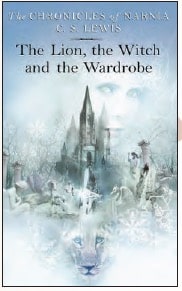 Summary: While staying at the home of an eccentric professor during World War II, the four Pevensie children — Lucy, Edmund, Susan and Peter — find their way into the world of Narnia through a magical wardrobe. Meeting both friend and foe, including a friendly faun, talking beavers, the mighty lion Aslan and the evil White Witch, the children quickly find themselves in the middle of a war to restore Narnia and take their places as kings and queens.
Summary: While staying at the home of an eccentric professor during World War II, the four Pevensie children — Lucy, Edmund, Susan and Peter — find their way into the world of Narnia through a magical wardrobe. Meeting both friend and foe, including a friendly faun, talking beavers, the mighty lion Aslan and the evil White Witch, the children quickly find themselves in the middle of a war to restore Narnia and take their places as kings and queens.
Themes: Consider how each child’s personal character is expressed in his or her first moments in Narnia. If you pay attention, you learn quite a lot about each of them right away. This will be helpful for looking back later — at the end of this book and from the end of Narnia as a whole — to see how each one changes, for better or worse. It is also worth paying attention to how sweet things enchant and disorient us (e.g., Turkish Delight), what betrayal is, why atonement is necessary, and where hope comes from.
………………………………………………………………………………………………………………………………………………………………….
Book 2: “Prince Caspian”
Dates to read: March 17-30
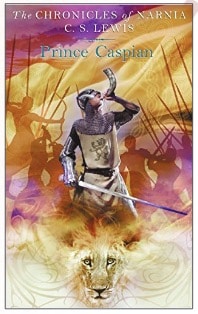 Summary: A year following their first journey to Narnia, the Pevensie children return to the magical land to discover that centuries have passed and war is once again on their doorstep. With the help of Aslan and Trumpkin the dwarf, the children join forces with the rightful ruler of the Telemarines, Prince Caspian, who has sided with the Old Narnians to fight his uncle, King Miraz.
Summary: A year following their first journey to Narnia, the Pevensie children return to the magical land to discover that centuries have passed and war is once again on their doorstep. With the help of Aslan and Trumpkin the dwarf, the children join forces with the rightful ruler of the Telemarines, Prince Caspian, who has sided with the Old Narnians to fight his uncle, King Miraz.
Themes: Ponder what it means for the children to recover their regal manners and mission. The air of Narnia works on them, but really it is Aslan’s call and desire that restores them to who they are meant to be in that place, for the good of all. What is it like to be summoned, to feel called? Where are the moments of trust and of trial in responding to a summons, a call?
“You doubt your value. Don’t run from who you are.”
— Aslan, “Prince Caspian”
…………………………………………………………………………………………………………………………………………………………………..
Book 3: “The Voyage of the Dawn Treader”
Dates to read: March 31-April 13
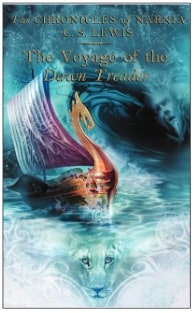 Summary: When Lucy and Edmund stay with their cousin, Eustace, all three find themselves thrust into Narnia through a painting of a ship at sea, the Dawn Treader. Captained by King Caspian, the ship and crew — including a mouse named Reepicheep — are on a quest to find the seven lost lords of Narnia. Their journey takes them to a dragon’s cave, a land with invisible occupants, an island covered in darkness, and even the end of the world to Aslan’s country.
Summary: When Lucy and Edmund stay with their cousin, Eustace, all three find themselves thrust into Narnia through a painting of a ship at sea, the Dawn Treader. Captained by King Caspian, the ship and crew — including a mouse named Reepicheep — are on a quest to find the seven lost lords of Narnia. Their journey takes them to a dragon’s cave, a land with invisible occupants, an island covered in darkness, and even the end of the world to Aslan’s country.
Themes: Keep in mind the power of desire and of duty, especially in characters like Reepicheep and Caspian. The prospect of adventure runs all through this tale, and adventure begins by peering into the unknown.
“… [O]ne of the most cowardly things ordinary people do is to shut their eyes to facts.”
— Eustace, “The Voyage of the Dawn Treader”
……………………………………………………………………………………………………………………………………………………………………
Book 4: “The Silver Chair”
Dates to read: April 14-27
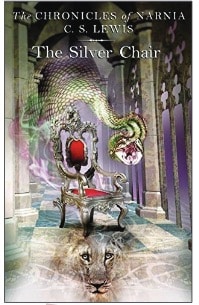 Summary: Eustace and his friend, Jill, narrowly escape school bullies by calling on Aslan, who whisks them into Narnia. Aslan then sends them on a quest to find the long-lost son of King Caspian, Prince Rilian, who disappeared while searching for the green serpent that killed his mother. Trying to follow the four signs Aslan gave them, Eustace and Jill travel through marshes, a castle of giants, and the Underland where they find a man tied to a silver chair, imprisoned by the Lady of the Green Kirtle.
Summary: Eustace and his friend, Jill, narrowly escape school bullies by calling on Aslan, who whisks them into Narnia. Aslan then sends them on a quest to find the long-lost son of King Caspian, Prince Rilian, who disappeared while searching for the green serpent that killed his mother. Trying to follow the four signs Aslan gave them, Eustace and Jill travel through marshes, a castle of giants, and the Underland where they find a man tied to a silver chair, imprisoned by the Lady of the Green Kirtle.
Themes: The question of memory spans the book and is the key to discerning truth from mere appearance. What is the importance of memory for perceiving the world and one’s own mission aright?
“You would not have called to me unless I had been calling to you.”
— Aslan, “The Silver Chair”
……………………………………………………………………………………………………………………………………………………………………
Book 5: “The Horse and His Boy”
Dates to read: April 28-May 11
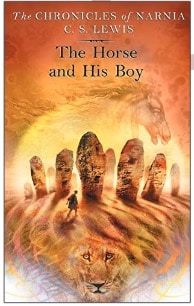 Summary: During the reign of Lucy, Edmund, Susan and Peter as kings and queens in Narnia, a young man named Shasta and a talking horse named Bree begin a journey to escape enslavement in the southern kingdom of Calormene. Joined by Aravis, who is fleeing a forced marriage, and her talking horse, Hwin, they encounter a plot to conquer the land of Narnia and force Queen Susan to marry the Calormene prince.
Summary: During the reign of Lucy, Edmund, Susan and Peter as kings and queens in Narnia, a young man named Shasta and a talking horse named Bree begin a journey to escape enslavement in the southern kingdom of Calormene. Joined by Aravis, who is fleeing a forced marriage, and her talking horse, Hwin, they encounter a plot to conquer the land of Narnia and force Queen Susan to marry the Calormene prince.
Themes: Think about how divine providence works, often unbeknownst to the characters at the time. To really see this and think about it, it’s important to see the whole story from the perspective of the end.
…………………………………………………………………………………………………………………………………………………………………..
Book 6: “The Magician’s Nephew”
Dates to read: May 12-25
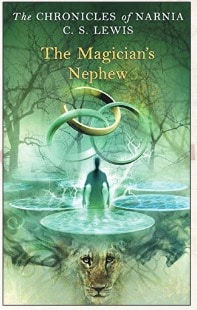 Summary: Friends Polly and Digory are set on a series of adventures when Digory’s evil Uncle Andrew gives them rings he believes will transport them to different worlds. The children find themselves in a wood between all worlds with ponds of water, which are entrances to different worlds. While world-hopping, Polly and Digory accidentally wake the evil Queen Jadis (the White Witch), witness the birth of Narnia, and are charged to protect it before returning home.
Summary: Friends Polly and Digory are set on a series of adventures when Digory’s evil Uncle Andrew gives them rings he believes will transport them to different worlds. The children find themselves in a wood between all worlds with ponds of water, which are entrances to different worlds. While world-hopping, Polly and Digory accidentally wake the evil Queen Jadis (the White Witch), witness the birth of Narnia, and are charged to protect it before returning home.
Themes: Contemplate how a person’s willingness to wonder and be awed affects how a person sees and hears what is going on around them. And, though magic is present throughout the books in the series, here it is especially worthwhile to perceive the difference between rogue magic and magic that is obedient to Aslan.
“Far overhead from beyond the veil of blue sky which hid them the stars sang again; … and the deepest, wildest voice they had ever heard was saying: ‘Narnia, Narnia, Narnia, awake. Love. Think. Speak. Be walking trees. Be talking beasts. Be divine waters.'”
— “The Magician’s Nephew“
…………………………………………………………………………………………………………………………………………………………………..
Book 7: “The Last Battle”
Dates to read: May 26-June 8
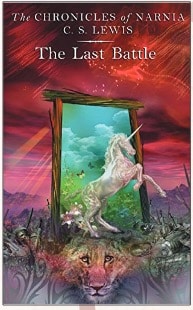 Summary: Narnians have lived in peace since King Caspian ruled, but deception threatens to divide the country during King Tirian’s reign. While calling on Aslan, Tirian sees a vision of many friends of Narnia living in our world — Lucy, Edmund, Peter, Eustace, Polly and Digory — who return to Narnia to help. Battle ensues between those loyal to Aslan and the troublemakers, which ends in judgment by Aslan to determine who will continue the adventure into his country.
Summary: Narnians have lived in peace since King Caspian ruled, but deception threatens to divide the country during King Tirian’s reign. While calling on Aslan, Tirian sees a vision of many friends of Narnia living in our world — Lucy, Edmund, Peter, Eustace, Polly and Digory — who return to Narnia to help. Battle ensues between those loyal to Aslan and the troublemakers, which ends in judgment by Aslan to determine who will continue the adventure into his country.
Themes: Reflect on how there really is an end to all matters of moral and spiritual judgment and how, at the end, choices and desires really do matter. It is also, of course, worthwhile to consider how the end of the journey through Narnia is the beginning of a journey into deeper and deeper joy.
“But for them it was only the beginning of the real story. All their life in this world and all their adventures in Narnia had only been the cover and the title page: now at last they were beginning Chapter One of the Great Story which no one on earth has read: which goes on for ever: in which every chapter is better than the one before.”
— “The Last Battle”
| Where To Meet Others On The Journey |
|---|
|
For more insights, a lecture series is being offered through Notre Dame’s McGrath Institute for Church Life under the title: “The Chronicles of Narnia: A Spiritual Journey.” The series, which runs March through April, also will be available online. Speakers include professors from Notre Dame, such as David Fagerberg, Leonard DeLorenzo, Francesca Murphy, Catherine Cavadini and Anthony Pagliarini, as well as those from other institutions: Michael Ward (Oxford University), Peter Schakel (Hope College) and Rebekah Lamb (University of St. Andrew’s). Dates for the series and links to the videos following each lecture can be found at: mcgrath.nd.edu/narnia. |






